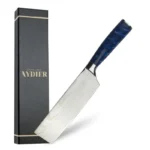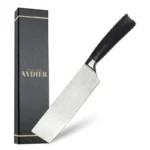Nakiri Knives

Nakiri Knife: The Japanese Vegetable Specialist
The Nakiri knife is a traditional Japanese knife designed specifically for preparing vegetables. Its name translates to “vegetable cutter,” reflecting its primary purpose. Unlike a Western chef’s knife, which has a curved blade suited for rocking motions, the Nakiri has a straight edge that excels at clean, up-and-down chopping. This design makes it a favorite in Japanese households for preparing everything from leafy greens to root vegetables with accuracy and speed.
Blade Design and Function
The Nakiri’s flat blade and squared tip make it especially efficient for cutting all the way through food without leaving uncut fibers at the bottom. This feature is particularly useful when working with ingredients like carrots, cucumbers, or herbs, where consistent slices are important. Its wide blade also helps lift and transfer chopped vegetables directly from the cutting board to the pan, making it practical for daily cooking.
Nakiri vs Santoku Knives
Many cooks compare Nakiri knives to Santoku knives, another popular Japanese style. While the Santoku is a versatile option for slicing vegetables, fish, and meat, the Nakiri focuses on one task: vegetables. Its edge does not curve, which means it does not perform as well in rocking cuts, but it delivers superior precision in straight downward motions. For anyone who prepares large amounts of produce, the Nakiri offers efficiency that even a Santoku cannot match.
Choosing the Right Nakiri Knife
Most Nakiri knives range between 6.5 and 7 inches in blade length, a size that balances control and cutting efficiency. The choice of material also matters. High-carbon steel blades hold a sharp edge longer but require attentive care to prevent rust. Stainless steel provides durability and easier maintenance, making it suitable for everyday use. Damascus steel combines performance with unique layered patterns, appealing to those who value both function and craftsmanship.
Care and Maintenance
Proper maintenance ensures the Nakiri remains sharp and reliable. Regular sharpening with a whetstone keeps the edge precise for thin slices and uniform cuts. Hand washing and immediate drying help protect the blade from corrosion, especially with high-carbon steel models. Storing the knife in a sheath, block, or on a magnetic strip prevents damage to the edge and extends its lifespan.
Why Add a Nakiri to Your Kitchen
Whether you are preparing a quick stir-fry or working through piles of vegetables for meal prep, a Nakiri knife provides efficiency and consistency. It is not designed for cutting through bones or tough meat, but as a dedicated vegetable knife, it stands out as a valuable companion to a chef’s knife or Santoku in any kitchen.

